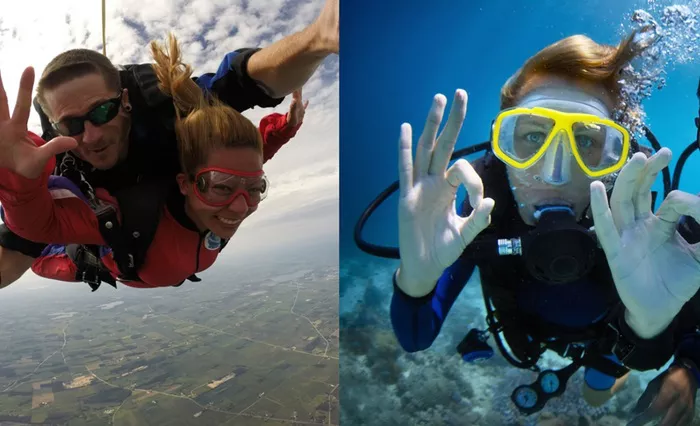When it comes to adventure sports, scuba diving and skydiving are two of the most thrilling activities one can experience. Both offer unique perspectives of the world, whether it’s exploring the underwater depths or free-falling from thousands of feet above the ground. However, the question often arises: which is safer, scuba diving or skydiving? This article delves into various aspects of both sports, comparing the risks, safety measures, and factors that contribute to their safety records.
Understanding the Risks Involved
The Risks of Scuba Diving
Scuba diving involves breathing compressed air underwater, exposing divers to unique risks. These include:
Decompression Sickness: Also known as “the bends,” this occurs when nitrogen bubbles form in the bloodstream due to rapid ascent.
Nitrogen Narcosis: At greater depths, high levels of nitrogen can impair a diver’s judgment and coordination.
Oxygen Toxicity: Breathing high concentrations of oxygen at depth can lead to seizures.
Equipment Failure: Issues with the diving gear, such as regulator malfunctions, can lead to emergencies underwater.
The Risks of Skydiving
Skydiving, on the other hand, involves jumping from an aircraft and free-falling before deploying a parachute. The primary risks include:
Parachute Malfunctions: While rare, issues with the main parachute or reserve can be life-threatening.
Hard Landings: Improper landing techniques can result in injuries ranging from sprains to fractures.
Weather Conditions: Adverse weather can affect the safety of the jump, including high winds or storms.
Safety Measures in Scuba Diving
Training and Certification
Before diving, individuals must undergo rigorous training and certification. Training includes theoretical knowledge, confined water dives, and open water dives to ensure divers are well-prepared for various situations.
Equipment Checks
Diving equipment must be regularly maintained and checked before each dive. This includes the regulator, buoyancy control device (BCD), tanks, and gauges. Properly functioning equipment is crucial for a safe dive.
Dive Planning
Planning a dive involves considering the dive site’s conditions, setting depth limits, and ensuring adequate surface intervals between dives. Divers often use dive tables or computers to track their nitrogen absorption.
Buddy System
Divers are encouraged to dive with a buddy to provide mutual assistance and enhance safety. The buddy system ensures that help is available in case of an emergency.
Safety Measures in Skydiving
Training Programs
Skydiving requires comprehensive training, including ground school and tandem jumps with an instructor. Advanced training involves solo jumps under the supervision of experienced skydivers.
Equipment Maintenance
Skydiving equipment, including the parachute, harness, and altimeter, must be meticulously maintained and inspected. Parachutes undergo regular repacking and inspections to ensure reliability.
Weather Assessment
Skydivers must assess weather conditions before a jump. Jumping in unsuitable weather, such as high winds or storms, increases the risk of accidents.
Emergency Procedures
Skydivers are trained in emergency procedures, such as deploying the reserve parachute if the main one fails. Familiarity with these procedures is essential for handling unexpected situations.
Statistical Comparison of Safety Records
Scuba Diving Safety Statistics
According to the Diver’s Alert Network (DAN), the fatality rate for scuba diving is approximately one death per 211,864 dives. Most incidents occur due to pre-existing health conditions, poor dive planning, or equipment failure.
Skydiving Safety Statistics
The United States Parachute Association (USPA) reports a fatality rate of about one death per 167,000 jumps. The majority of accidents result from human error, such as improper parachute deployment or incorrect landing techniques.
see also: How Much Does Indoor Skydiving Cost?
Factors Influencing Safety
Experience Level
Both scuba diving and skydiving have steep learning curves. Experience and continuous training significantly reduce the risks associated with both sports. Experienced divers and skydivers are better equipped to handle emergencies.
Health and Fitness
Good physical health is essential for both activities. Pre-existing health conditions can exacerbate the risks involved. Regular medical check-ups are advised for participants in both sports.
Environmental Conditions
Environmental factors play a significant role in safety. Divers must be aware of marine life, water currents, and visibility. Skydivers need to consider wind speed, cloud cover, and temperature.
Personal Responsibility
Personal responsibility and adherence to safety protocols are paramount. Participants must follow training guidelines, use equipment correctly, and avoid risky behaviors.
Conclusion
In comparing the safety of scuba diving and skydiving, it becomes evident that both sports carry inherent risks. However, with proper training, equipment maintenance, and adherence to safety measures, these risks can be significantly mitigated. Statistically, skydiving has a slightly higher fatality rate compared to scuba diving, but both sports are considered relatively safe when performed under controlled conditions. Ultimately, the choice between scuba diving and skydiving should be based on personal preferences, health conditions, and a thorough understanding of the associated risks and safety protocols.
FAQs:
What are the main causes of accidents in scuba diving?
Accidents in scuba diving are primarily caused by decompression sickness, equipment failure, and pre-existing health conditions. Proper training, equipment checks, and dive planning can prevent most incidents.
How often should skydiving equipment be inspected?
Skydiving equipment, particularly parachutes, should be inspected before every jump and undergo regular maintenance checks. Parachutes are typically repacked every 180 days.
Can people with health conditions participate in scuba diving or skydiving?
Individuals with certain health conditions should consult a medical professional before participating in either sport. Conditions such as heart problems, respiratory issues, or epilepsy may require special considerations.
What is the importance of the buddy system in scuba diving?
The buddy system enhances safety by providing mutual assistance. Buddies can help each other with equipment checks, share air in emergencies, and offer support during the dive.
Are there any age restrictions for scuba diving or skydiving?
Both sports have age restrictions for safety reasons. Scuba diving is generally recommended for individuals aged 10 and above, while skydiving often has a minimum age requirement of 18. Some locations may offer tandem jumps for younger participants with parental consent.
related topics:
- Bungee Jumping Or Skydiving: Which Is Scarier?
- What To Wear For Skydiving?
- What To Expect When Skydiving?

